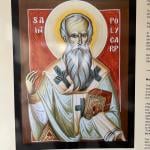What happened to Trinitarian theology between the Reformation and the eighteenth century. The closest thing I’ve found to an answer is Philip Dixon’s Nice and Hot Disputes, which summarizes some of the developments in seventeenth-century England. Here are some of his main points.
1) Because of Socinianism, Trinitarian theologians were put on the defensive. Through the Racovian Catechism (1605) and other writings, the Socinian denial of the deity of Christ spread from Poland to the rest of Europe. The catechism states, in part:
Q. You said a little before that the Lord Jesus is a man by nature, hath he not also a divine Nature?
A. At no hand; for that is repugnant not onely to sound Reason, but also to the holy Scriptures.
Q. Shew me how it is repugnant to sound Reason.
A. First, because two substances indued with opposite properties, cannot combine into one Person, and such properties are mortality and immortality; to have beginning, and to be without beginning; to be mutable, and immutable. Again, two Natures, each whereof is apt to constitute a severall person, cannot be huddled into one Person. For instead of one, there must of necessity arise two persons, & consequently become two Christs, whom all men without controversie acknowledge to be one, and his Person one.
Q. But when they alledge that Christ is so constituted of a divine and humane Nature, as a man is of a body and soul, what answer must we make to them?
A. That in this case there is a wide difference; for they say that the two Natures in Christ are so united that Christ is both Cod and Man. Whereas the soul and body in a man are so conjoyned as that a man is neither soul nor body. For neither doth the soul nor the body severally constitute a Person. But as the divine Nature doth by it self constitute a Person, so must the humane by it self of necessity also constitute.
Q. Shew how it is also repugnant to the Scripture that Christ should have a divine Nature.
A. First, because the Scripture proposeth to us but one God by nature, whom we formerly demonstrated to be the Father of Christ. Secondly, the same Scripture witnesseth that Jesus Christ is a man by nature, as was formerly shewn. Thirdly, because whatsoever divine excellency Christ hath, the Scripture testifieth that he hath it by gift of the Father. John 3.35. John 5. 19, 20, 21, 22, 23, 26, 27. John 10.25. John 13.3. John 14.10. Acts 2.33. Rev. 2.26, 27. 2 Pet. 1.17. Finally, because the Scripture doth most evidently shew, that Jesus Christ doth perpetually ascribe all his Divine acts not to himself, or any Divine nature of his own, but to the Father; who seeth not that such a Divine nature as the Adversaries imagine in Christ, would have been altogether idle, and of no use? . . .
The effect of Socianianism was to put the orthodox on the defensive. They spent their time refuting heresy instead of developing the doctrine. As Trinitarian theology becomes more defensive, “the Trinitarian imagination contracts” (p. 12).
2) At the center of Dixon’s history is a debate about the nature of personality. Thomas Hobbes is one source of a change in the definition of personhood. “Person” was defined in terms of representation, which, when applied to the Trinity, leads to modalistic conclusions. For much of the century, a debate raged concerning the nature of person.
In Leviathan, chapter 42, Hobbes laid out his theory:
“But a person (as I have shown before, Chapter thirteen) is he that is represented, as of as he is represented; and therefore God, who has been represented (that is, personated) thrice, may properly enough be said to be three persons; though neither the word Person nor Trinity be ascribed to him in the Bible. St. John indeed saith, ‘There be three that bear witness in heaven, the Father, the Word, and the Holy Spirit; and these three are one’:[Luke, 5. 11] but this disagreeth not, but accordeth fitly with three persons in the proper signification of persons; which is that which is represented by another. For so God the Father, as represented by Moses, is one person; and as represented by His Son, another person; and as represented by the Apostles, and by the doctors that taught by authority from them derived, is a third person; and yet every person here is the person of one and the same God . . . . To conclude, the doctrine of the Trinity, as far as can be gathered directly from the Scripture, is in substance this: that God, who is always one and the same, was the person represented by Moses; the person represented by his Son incarnate; and the person represented by the Apostles. As represented by the Apostles, the Holy Spirit by which they spoke is God; as represented by His Son, that was God and man, the Son is that God; as represented by Moses and the high priests, the Father, that is to say, the Father of our Lord Jesus Christ, is that God: from whence we may gather the reason those names Father, Son, and Holy Spirit, in the signification of the godhead, are never used in the Old Testament: for they are persons, that is, they have their names from representing; which could not be till diverse men had represented God’s person in ruling or in directing under Him.”
3) There was a shift in overall intellectual mood. Metaphor and analogy became less appreciated, and clear and distinct and unambiguous language and ideas were privileged. The decline of Trinitarian theology was thus part of the counter-Renaissance movement that Stephen Toulmin says was the source of modernity.
4) Finally, though Dixon does not develop it, the attack on reliability of the gospels and the historical Jesus was part of this history. The doctrine of the Trinity arose out of reflection on the gospel story. For the church fathers, the question was, who must God be in order for the gospel story to be accurate to His character? With the gospel texts under attack, Trinitarian theology couldn’t be sustained.











